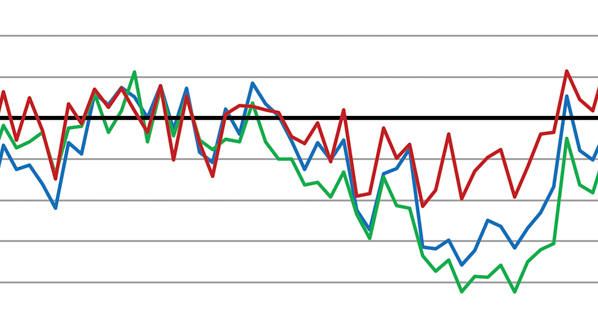Restoring Control Over Strategic Sourcing and Inventory Management

By Wil G. Knibloe III, managing principal, supply chain and Stephen F. Wiley is principal and manufacturing advisory leader with Crowe.
After several tumultuous years of pandemic-driven supply chain disruptions, many businesses report that the tide is beginning to turn. Although significant uncertainty remains, price increases have slowed or stopped, inventories are stabilizing (though remain quite high), and order bookings have slowed or are returning to more normal patterns.
At this stage, organizations can begin focusing on three important priorities: regaining some of the margin they lost due to sudden raw material and component price increases, restoring inventory stockpiles to more rational levels, and reworking their supply chain and inventory practices to be better prepared to handle future disruptions.
In many instances, businesses can accelerate these efforts by applying two distinct but closely related disciplines: strategic sourcing and inventory management.
Strategic Sourcing: Beyond Procurement
Over the past few years, many procurement offices were whipsawed by dramatically shifting priorities. Price considerations, which took precedence throughout much of the 2010s, were suddenly rendered immaterial by pandemic-driven shortages. Almost overnight, simply getting reliable access to essential raw materials and components became the driving concern.
In an effort to avert possible shortages, many companies began stockpiling inventories of critical goods, often incurring significant carrying costs. In many cases, procurement offices that had long relied on single-source vendors suddenly had to scramble to find alternatives — often at significantly higher cost with less consistent quality and reliability. With contract commitments making it impossible to pass on cost increases to customers, margins often shrank drastically.
One of the objectives of strategic sourcing is to help avoid such reactive responses to unforeseen supply chain issues. In addition, strategic sourcing goes beyond purchasing or procurement alone to add value to the organization in other ways.
The tactical components of procurement — such as vendor qualification, invoicing and payment, requisition and purchase order management, and control of rampant spend — are essential for effective spend management. But strategic sourcing moves beyond these transactional elements to implement a structured, objective and comprehensive program that encompasses broader elements such as supplier selection, negotiations, contract management, performance management and value improvement.
In addition to helping normalize the supply chain and reduce supply chain risk, strategic sourcing can drive improved operational performance and produce measurable bottom-line results.
A Structured Approach
In most instances, an effective strategic sourcing effort encompasses four essential components:
- Spend visibility. The first step is to gain better visibility into, and understanding of, current spend and how it’s managed. A comprehensive survey of all accounts payable should produce answers to five critical questions for each vendor: What category of goods do we buy from this vendor? Do we have a contract or an informal agreement? Who selected and manages the spend for this vendor? When and how was the agreement last negotiated? And where are we single–sourced? These insights are the basis of understanding addressable spend and supply chain risk.
- Analysis and categorization. The next step is a deeper dive into current spend to further qualify areas of risk and opportunity. The goal is to recognize those spend categories where the organization might have leverage to negotiate, versus those where sourcing is more specialized or constrained. This analysis will also help identify those vendors with which the organization should work to develop cooperative relationships, as well as those where it might be advisable to consider winding things down or proactively qualifying alternatives.
- Strategy development. Here, organizations can apply any of four basic strategies: category sourcing events such as competitive bids or requests for proposals, direct negotiations with select vendors, demand management to identify opportunities to reduce costs, and joint supplier development and performance improvement management, in those cases where it’s possible to drive value and operational improvement for both parties.
- Implementation and execution. The best results are achieved when progress is transparent, and the initiative has the backing of executive leadership. Effective measurement of results is critical, but useful dashboards don’t have to be complex. In many cases, simple tools and clear metrics can provide the visibility that’s needed to drive accountability, maintain momentum and identify areas where leadership should get involved to clear bottlenecks or exercise governance.
The opportunities to drive improved margin while de-risking a company’s supply chain are apparent. The benefits will go to those that organize a strategy and execute. Conversely, customers will be approaching suppliers for price decreases; as such, leaders should organize an intelligent defense that’s grounded in a segmented customer strategy.
Inventory Management: Current Issues
Post-pandemic performance improvement requires effective inventory management. In many instances, enterprise resource planning (ERP) system parameters — such as minimum levels of safety stock, recommended reorder points, expected lead times and order quantities — were ignored or overridden as companies scrambled to deal with recurring shortages.
In the end, the unprecedented disruptions invalidated many established system parameters. Lagging lead times necessitated higher levels of safety stock and accelerated reorder points. In addition, purchasers understandably increased order quantities, anticipating that suppliers would fail to fill orders completely. The result was a cascading series of changes that triggered further uncertainty.
In the aftermath of these events, it’s time for many organizations to revisit their existing ERP system parameters and prepare to make significant adjustments to their inventory replenishment practices in line with current realities. Such reviews should be scheduled on a regular basis.
Advanced Strategies
Advanced inventory-management strategies can add even more value to the organization. For example, the application of product lifecycle management practices can help improve overall inventory performance, reduce costs and potentially drive an increase in margin through a multifaceted complexity reduction strategy.
Stock-keeping unit rationalization is probably the best-known example of such practices, but it’s far from the only tool available to managers. Standardization of components across product lines can help reduce the proliferation of raw material inventories. Product and customer rationalization can reveal opportunities to adjust pricing in a way that more accurately reflects the nature of specialty products or customization.
In many cases, manufacturers can reduce finished goods inventories by restructuring the assemble-to-order environment. For example, by postponing the final assembly of major product components until customer orders are actually in hand, many companies have found they can delay the final value-add of the process, thus retaining subcomponents as works in process rather than finished goods.
Strategies such as these can deliver measurable improvements to a company’s cash and working capital positions. In addition to providing an immediate one-time reduction in inventories, they can help to reduce annualized carrying costs, and might even open up physical space to enable either future expansions or reduced facility costs.
The combined financial impacts of strategic sourcing and improved inventory management can be significant, especially in light of the turmoil of the past several years. Beyond their immediate financial impacts, however, these combined strategies offer long-term improvement opportunities by providing a foundation for more effective risk management, and empowering leadership teams to build more resilient organizations that are capable of responding quickly and resourcefully to future events.







